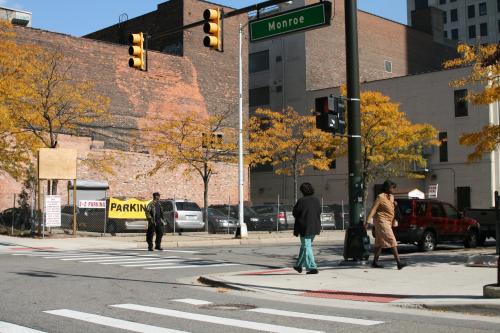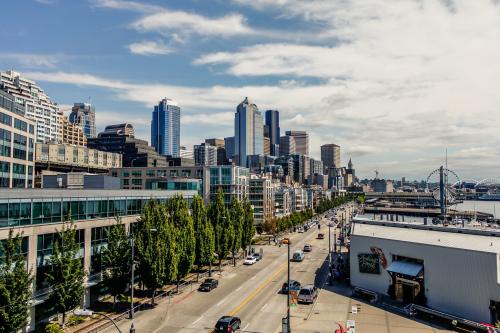This story was produced by The Hechinger Report, a nonprofit, independent news organization focused on inequality and innovation in education. Read more about education in New Orleans.
What won’t mayors do to attract a new Amazon headquarters to their city? Tucson’s economic development group presented a 21-foot saguaro cactus to Amazon’s main Seattle office. Stonecrest, Ga. offered to rename itself Amazon. Even New York City mayor Bill de Blasio lit up the Empire State Building in Amazon’s signature orange color.
In early September, Amazon released a request for proposal (RFP) for its second North American headquarters, already known as HQ2. The company plans to make 50,000 hires in an industry that can propel workers to the middle class and position cities as leaders of the “next economy.” The average annual salary of an HQ2 employee will exceed $100,000, according to the RFP. All of the prospective suitors offered billions in tax breaks against city and state taxes.
But what lengths will mayors go to create an inclusive economy? Mayors should strive for more than just what Amazon wants — they should demand that employers commit to hiring those who find it difficult to adapt to the information age, such as people without a college degree, who make up more than half of the out-of-work population in the kind of cities Amazon is hoping to land. Whichever city wins the contest — now closed — there will be many of its residents who lose.
The day after the deadline for cities to submit their packages to Amazon, Brookings colleague Bruce Katz tweeted, “What if all cities treated their inclusion challenges like the Amazon competition?”
It’s time cities played a game of their own. In exchange for tax breaks, cities should have companies train those residents who might lose out if Amazon comes to town.
It’s time cities played a game of their own. In exchange for tax breaks, cities should have companies train those residents who might lose out if Amazon comes to town. We’ve seen what happened in the Bay area, when long-term city dwellers who weren’t drawing hefty paychecks from the likes of Apple, Facebook or Google were priced out of their neighborhoods.
“Silicon Valley tech companies love to build super awesome campuses that their employees will never want to leave,” writes reporter Emma Grey Ellis, “[T]hey’re also at least partially responsible for tech’s biggest sins: a lack of diversity and gentrification.”
Amazon is skilled at using competition to its advantage, receiving financial benefits from multiple cities that use them as inducements to have a piece of one of the largest companies in the world. The economic development policy group Good Jobs First, a watchdog of sorts that has documented Amazon’s exchanges with cities preceding the competition, found that “Amazon has continued to receive subsidies from cities valued at least $115 million (not including four deals of undisclosed value), for a long-term total exceeding $1 billion.”
What’s less clear is what cities stand to gain from participating. Who gains the most? Upwards of 50,000 hires at an average salary of $100,000 is certainly a benefit to the home of HQ2, not to mention the $5 billion in capital expenditures Amazon plans to fork over to build it. However, the RFP also states, “A highly educated labor pool is critical and a strong university system is required.” Amazon wants people who are already “work ready,” in a city that already possesses the educational institutions to produce them.
More high-paying jobs should not be the sole measure of reward. Sure, if your mayor is selling your city, you’d like to see more and better-paying jobs in return. But if you’re not working at a place like Amazon, its presence can price you out, and divide your city into enclaves of the haves and have-nots.
What if we used innovation and competition to build inclusive economies instead?
The gambit of offering tax incentives while promoting the idea that employees must enter the door “work ready” is decreasing cities’ and states’ abilities to fund the building of an inclusive workforce.
We share a collective responsibility in training those who don’t yet have the skills to work at places like Amazon. Schools, universities and private industry all play a role. Each needs resources to do the arduous work of training underrepresented folk in industries that have left them in the dust. However, the gambit of offering tax incentives while promoting the idea that employees must enter the door “work ready” is decreasing cities’ and states’ abilities to fund the building of an inclusive workforce.
Businesses can eradicate racial and educational disparities in the workforce tomorrow if they hire underrepresented groups today, though it’s unreasonable to think companies will hire people not ready for the job. Still, it’s also not right for companies to absolve themselves from participating in training people. Schools clearly can’t shoulder all the responsibility of preparing the public for the workforce — that has long been the model, and it is not working for everyone.
Businesses that are retreating from training and workforce development contribute to the state we’re currently in. For instance, apprenticeships that were once integral to professional guilds of law and carpentry have been slowly replaced with certification, degree and other programs found in higher ed. If tech work is ubiquitous and basic, college can’t be the only place we can get training. And too many people who can’t afford to go to Stanford, Berkeley or MIT are not able to compete in the current economy.
We need more internships, apprenticeships and employer-based training and work centers that provide practical skills. Learning on the job is part of the educational process.
If companies don’t embrace their role in the workforce development pipeline, they should provide the revenues to other institutions that are willing meet the needs of society.
We are becoming too reliant on non-profits and one-off programs such as Byte Back in Washington, D.C., Computer Core in Falls Church, Va. and Skillful in Colorado to prepare folks without top college degrees on their resumes to enter the workforce. Only private industry can help scale these efforts to match the need for them. We aren’t going to nonprofit our way to an inclusive economy. If companies don’t embrace their role in the workforce development pipeline, they should provide the revenues to other institutions that are willing meet the needs of society.
Clearly, there must be a balance. Cities need private industry to have an environment that’s good for business, but industry must also see itself as a part of the community — and be a good neighbor. That means bearing some responsibility in training potential workers.
Cities can benefit from innovative competition that spurs economic development. But we need to remember that our biggest problem has been investing in people who aren’t part of our social networks.






Commentary
Cities bidding for Amazon HQ2 should have played their own game
October 24, 2017